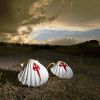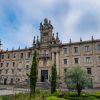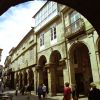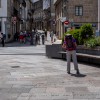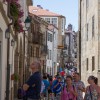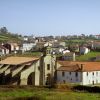- Accede I
- Regístrate I
- carrito
09. Plaza de la Quintana
09. Plaza de la Quintana
Galería de imágenes

Decir Plaza de la Quintana es una redundancia, ya que la voz ‘quinta’ o ‘quintana’ hace referencia a un lugar público abierto. Mientras el espacio superior, al final de las escaleras, se conoce como “Quintana de Vivos”, la gran explanada que pisamos es la llamada “Quintana de Mortos”, pues fue en otro tiempo el gran cementerio de la ciudad. Además de albergar tumbas romanas y altomedievales descubiertas durante las excavaciones de la Catedral y sus alrededores, la plaza fue lugar de enterramientos hasta el siglo XVIII, momento en el que por razones sanitarias y falta de espacio se decidió buscar otro emplazamiento.
Desde esta trasera descubrimos la fachada de la Puerta Santa de la catedral, que sólo se abre en los Años Santos para que los creyentes que la crucen puedan ganar la absolución plenaria, tras confesarse y comulgar. Este privilegio, otorgado a la Catedral en 1122 y ratificado poco después, dio a Santiago su carácter de ciudad santa de la cristiandad. Mirando tras las rejas se puede ver la cabecera románica de la catedral. En la fachada, la parte superior está presidida por el apóstol con sus dos discípulos. En la parte inferior, y a ambos lados de la entrada, vemos 24 figuras insertadas, traídas del antiguo coro pétreo del maestro Mateo, desmontado en el siglo XVI.
A nuestras espaldas, se levanta el imponente muro del Monasterio de San Paio de Antealtares con sus 48 ventanas enrejadas. Alfonso II lo fundó en el siglo IX, para que los monjes custodiasen los restos del Apóstol, ante el temor de que fuesen robados.
Los benedictinos fueron sustituidos hacia finales del siglo XV por las benedictinas de clausura que desde entonces habitan este edificio. Estas monjas fabrican dulces y los venden por el torno ubicado en la calle de San Paio, justo al otro lado del convento.
Cuenta una leyenda que un universitario se enamoró apasionadamente de una joven novicia del convento. Una noche, al intentar subir a su ventana, el joven cayó y murió a los pies del largo muro. Desde entonces, algunos dicen que su espíritu vaga perdido buscando a su amada por este lugar. El ambiente mágico que crea la noche en la plaza también fue descrito por Federico García Lorca, que en sus ‘Poemas Galegos’ recitaba: ‘Fita seu corpo transido, / negro de somas e lobos. / Nai: A lúa está bailando / na Quintana dos mortos’.
Esta plaza ha sido en realidad gran espectadora de la historia. Escuchó los primeros pregones municipales del medioevo, albergó el primer Ayuntamiento de la ciudad, vio nacer la Universidad en el monasterio de San Paio y fue mercado y escenario de las más diversas manifestaciones políticas de la historia urbana. Fue testigo de cómo un batallón formado por mil estudiantes y profesores de la Universidad de Santiago marchó a enfrentarse a las tropas francesas durante la Guerra de Independencia, impidiendo la caída de Galicia una noche de mayo de 1808. En su memoria, la Quintana se llamó en una época Plaza de los Literarios, como recuerda una placa colocada en el muro del monasterio.
Puede que tanta historia acumulada, sea el motivo que ha llevado a esta plaza a recibir el nombre de Plaza de la Quintana, plaza de plazas.













